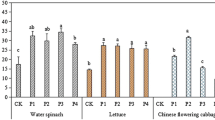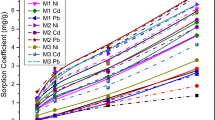Abstract
Soil contamination with toxic metals has increasingly become a global concern over the past few decades. Phosphate and carbonate compounds are good passivation materials for Pb immobilization, while the effect of phosphate and carbonate on the immobilization of multiple heavy metals (Pb, Cu, and Cd) in contaminated soils was seldom investigated. In this study, bone meal (BM), phosphate rock (PR), oxalic acid-activated phosphate rock (APR), super phosphate (SP), and calcium carbonate (CC) were added to the contaminated soils to evaluate the effect of phosphate materials and calcium carbonate on the immobilization of Pb, Cu, and Cd. The results showed that the pH of the treated soils increased 1.3–2.7, except SP which decreased 0.5 at most. Compared to the control treatment, all phosphates and calcium carbonate added to the polluted soils increased the fraction of residual metals, and the application of APR, PR, BM, and CC significantly reduced exchangeable and carbonate-bound fraction metals. PR and APR were the most effective for the immobilization of Pb, Cu, and Cd in the soils among these materials. Moreover, the concentrations of all metals in the toxicity characteristic leaching procedure (TCLP) leachate decreased with increasing amounts of amendments, and the concentrations of Pb in the TCLP leachate for soils treated with PR and APR were below the nonhazardous regulatory limit of 5 mg L−1 (US Environmental Protection Agency). Based on our results, phosphate rock and oxalic acid-activated phosphate rock are effective in the immobilization of multiple metals by reducing their mobility in the co-contaminated soils.







Similar content being viewed by others
References
Abbaspour A, Golchin A (2011) Immobilization of heavy metals in a contaminated soil in Iran using di-ammonium phosphate, vermicompost and zeolite. Environ Earth Sci 63(5):935–943
Adriano DC, Wenzel WW, Vangronsveld J, Bolan NS (2004) Role of assisted natural remediation in environmental cleanup. Geoderma 122(2):121–142
Bacon JR, Davidson CM (2008) Is there a future for sequential chemical extraction? Analyst 133(1):25–46
Basta NT, Gradwohl R, Snethen KL, Schroder JL (2001) Chemical immobilization of lead, zinc, and cadmium in smelter-contaminated soils using biosolids and rock phosphate. J Environ Qual 30(4):1222–1230
Basta NT, McGowen SL (2004) Evaluation of chemical immobilization treatments for reducing heavy metal transport in a smelter-contaminated soil. Environ Pollut 127(1):73–82
Bolan NS, Adriano DC, Mani PA, Duraisamy A (2003) Immobilization and phytoavailability of cadmium in variable charge soils: II. Effect of lime addition. Plant Soil 250(2):187–198
Cao RX, Ma LQ, Chen M, Singh SP, Harris WG (2003) Phosphate-induced metal immobilization in a contaminated site. Environ Pollut 122(1):19–28
Cao XD, Dermatas D, Xu FX, Shen G (2008) Immobilization of lead in shooting range soils by means of cement, quicklime, and phosphate amendments. Environ Sci Pollut Res 15(2):120–127
Cao XD, Ma LQ, Chen M, Singh SP, Harris WG (2002) Impacts of phosphate amendments on lead biogeochemistry at a contaminated site. Environ Sci Technol 36(24):5296–5304
Cao XD, Wahbi A, Ma L, Li B, Yang Y (2009) Immobilization of Zn, Cu, and Pb in contaminated soils using phosphate rock and phosphoric acid. J Hazard Mater 164(2):555–564
Chen S, Xu M, Ma Y, Yang J (2007) Evaluation of different phosphate amendments on availability of metals in contaminated soil. Ecotox Environ Safe 67(2):278–285
Elouear Z, Bouhamed F, Bouzid J (2014) Evaluation of different amendments to stabilize cadmium, zinc, and copper in a contaminated soil: influence on metal leaching and phytoavailability. Soil Sediment Contam: An Intl J 23(6):628–640
Garau G, Castaldi P, Santona L, Deiana P, Melis P (2007) Influence of red mud, zeolite and lime on heavy metal immobilization, culturable heterotrophic microbial populations and enzyme activities in a contaminated soil. Geoderma 142(1):47–57
Hettiarachchi GM, Pierzynski GM, Ransom MD (2001) In situ stabilization of soil lead using phosphorus. J Environ Qual 30(4):1214–1221
Houben D, Pircar J, Sonnet P (2012) Heavy metal immobilization by cost-effective amendments in a contaminated soil: effects on metal leaching and phytoavailability. J Geochem Explor 123:87–94
Janoš P, Vávrová J, Herzogová L, Pilařová V (2010) Effects of inorganic and organic amendments on the mobility (leachability) of heavy metals in contaminated soil: a sequential extraction study. Geoderma 159(3):335–341
Jiang GJ, Liu YH, Huang L, Fu QL, Deng YJ, Hu HQ (2012) Mechanism of lead immobilization by oxalic acid-activated phosphate rocks. J Environ Sci-China 24(5):919–925
Kabas S, Faz A, Acosta JA, Zornoza R, Martínez-Martínez S, Carmona DM, Bech J (2012) Effect of marble waste and pig slurry on the growth of native vegetation and heavy metal mobility in a mine tailing pond. J Geochem Explor 123:69–76
Kede MLFM, Correia FV, Conceição PF, Junior SFS, Marques M, Moreira JC, Pérez DV (2014) Evaluation of mobility, bioavailability and toxicity of Pb and Cd in contaminated soil using TCLP, BCR and earthworms. Int J Environ Res Public Health 11(11):11528–11540
Knox AS, Kaplan DI, Paller MH (2006) Phosphate sources and their suitability for remediation of contaminated soils. Sci Total Environ 357(1):271–279
Lado LR, Hengl T, Reuter HI (2008) Heavy metals in European soils: a geostatistical analysis of the FOREGS Geochemical database. Geoderma 148(2):189–199
Laperche V, Traina SJ, Gaddam P, Logan TJ (1996) Chemical and mineralogical characterizations of Pb in a contaminated soil: reactions with synthetic apatite. Environ Sci Technol 30(11):3321–3326
Lee SH, Park H, Koo N, Hyun S, Hwang A (2011) Evaluation of the effectiveness of various amendments on trace metals stabilization by chemical and biological methods. J Hazard Mater 188(1):44–51
Lee SS, Lim JE, El-Azeem SAA, Choi B, Oh SE, Moon DH, Ok YS (2013) Heavy metal immobilization in soil near abandoned mines using eggshell waste and rapeseed residue. Environ Sci Pollut Res 20(3):1719–1726
Lehoczky É, Marth P, Szabados I, Szomolányi A (2000) Applications in food quality and environmental contamination: the cadmium uptake by lettuce on contaminated soil as influenced by liming. Commun Soil Sci Plan 31(11–14):2433–2438
Ma QY, Traina SJ, Logan TJ, Ryan JA (1994) Effects of aqueous Al, Cd, Cu, Fe(II), Ni, and Zn on Pb immobilization by hydroxyapatite. Environ Sci Technol 8(7):1219–1228
Mackie KA, Müller T, Kandeler E (2012) Remediation of copper in vineyards—a mini review. Environ Pollut 167:16–26
Megateli S, Semsari S, Couderchet M (2009) Toxicity and removal of heavy metals (cadmium, copper, and zinc) by Lemna gibba. Ecotox Environ Safe 72(6):1774–1780
Mignardi S, Corami A, Ferrini V (2012) Evaluation of the effectiveness of phosphate treatment for the remediation of mine waste soils contaminated with Cd, Cu, Pb, and Zn. Chemosphere 4(4):354–360
Moon DH, Park JW, Cheong KH, Hyun S, Koutsospyros A, Park JH, Ok YS (2013) Stabilization of lead and copper contaminated firing range soil using calcined oyster shells and fly ash. Environ Geochem Health 35(6):705–714
Mouta ER, Soares MR, Casagrande JC (2008) Copper adsorption as a function of solution parameters of variable charge soils. J Brazil Chem Soc 19(5):996–1009
Osborne LR, Baker LL, Strawn DG (2015) Lead immobilization and phosphorus availability in phosphate-amended mine-contaminated soils. J Environ Qual 44(1):183–190
Ryan JA, Zhang P, Hesterberg D, Chou J, Sayers DE (2001) Formation of chloropyromorphite in a lead contaminated soil amended with hydroxyapatite. Environ Sci Technol 35(18):3798–3803
Stegmann R, Brunner G, Calmano W, Matz G (2001) Treatment of contaminated soil: fundamentals, analysis, applications. Springer, Berlin
Su XJ, Zhu J, Fu QL, Zuo JC, Liu YH, Hu HQ (2015) Immobilization of lead in anthropogenic contaminated soils using phosphates with/without oxalic acid. J Environ Sci-China 28:64–73
Tessier A, Campbell PGC, Bisson M (1979) Sequential extraction procedure for the speciation of particulate trace metals. Anal Chem 51(7):844–851
Theodoratos P, Papassiopi N, Xenidis A (2002) Evaluation of monobasic calcium phosphate for the immobilization of heavy metals in contaminated soils from Lavrion. J Hazard Mater 94(2):135–146
Wang L, Zhang Y, Lian J, Chao J, Gao Y, Yang F, Zhang L (2013) Impact of fly ash and phosphatic rock on metal stabilization and bioavailability during sewage sludge vermicomposting. Bioresour Technol 136:281–287
Wu WH, Xie ZM, Xu JM, Wang F, Shi JC, Zhou RB, Jin ZF (2013) Immobilization of trace metals by phosphates in contaminated soil near lead/zinc mine tailings evaluated by sequential extraction and TCLP. J Soil Sediment 13(8):1386–1395
Zhang P, Ryan JA (1999) Transformation of Pb(II) from cerussite to chloropyromorphite in the presence of hydroxyapatite under varying conditions of pH. Environ Sci Technol 33(4):625–630
Acknowledgments
This project was financially supported by the Natural Science Foundation of China (41371470) and the National Key Technology Support Program (2015BAD05B00).
Author information
Authors and Affiliations
Corresponding author
Additional information
Responsible editor: Zhihong Xu
Rights and permissions
About this article
Cite this article
Huang, G., Su, X., Rizwan, M.S. et al. Chemical immobilization of Pb, Cu, and Cd by phosphate materials and calcium carbonate in contaminated soils. Environ Sci Pollut Res 23, 16845–16856 (2016). https://doi.org/10.1007/s11356-016-6885-9
Received:
Accepted:
Published:
Issue Date:
DOI: https://doi.org/10.1007/s11356-016-6885-9




